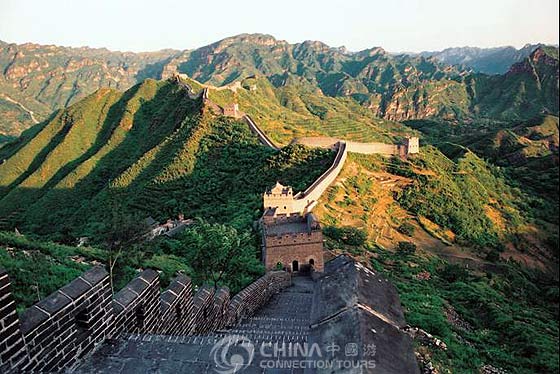 Built in 557 AD and repaired in the Ming Dynasty (1368-1644), The Great Wall at Huangyaguan geographically belongs to Ji County at the very northern tip of the Tianjin Municipality and is some 28km north of Jixian County Town. "Huangya" means "yellow cliff". The pass takes this name from the yellowish hills and rocks nearby. The pass, the only one of its kind in Ji County, contains the section of the Great Wall that extends northward to Hebei Province. During the sunset, the pass looks even more imposing with the steep slopes on both sides. Even during the Qing Dynasty over two thousand ago, it was an important pass in northern China. In recent years, some new features have been added to the original construction, such as the Eight Diagrams Labyrinth, the Forest of Steles, a museum and the Water Pass (Shui guan). The wall here has also been renovated recently, although its edges still show signs of decaying age. The most redeeming factor of this section is that it is less plagued by tourists than its Beijing counterparts. At his commanding height, one can truly appreciate the saying, "If one man guards the pass, ten thousand are unable to get through."
Built in 557 AD and repaired in the Ming Dynasty (1368-1644), The Great Wall at Huangyaguan geographically belongs to Ji County at the very northern tip of the Tianjin Municipality and is some 28km north of Jixian County Town. "Huangya" means "yellow cliff". The pass takes this name from the yellowish hills and rocks nearby. The pass, the only one of its kind in Ji County, contains the section of the Great Wall that extends northward to Hebei Province. During the sunset, the pass looks even more imposing with the steep slopes on both sides. Even during the Qing Dynasty over two thousand ago, it was an important pass in northern China. In recent years, some new features have been added to the original construction, such as the Eight Diagrams Labyrinth, the Forest of Steles, a museum and the Water Pass (Shui guan). The wall here has also been renovated recently, although its edges still show signs of decaying age. The most redeeming factor of this section is that it is less plagued by tourists than its Beijing counterparts. At his commanding height, one can truly appreciate the saying, "If one man guards the pass, ten thousand are unable to get through."

